Performance Management in UK Banking Industry: A Detailed Report
VerifiedAdded on 2023/04/26
|42
|13479
|160
Report
AI Summary
This report examines performance management within the UK banking sector, focusing on its significance and effectiveness. It begins with an overview of human resource management and performance management, highlighting their importance in today's competitive landscape. The report then delves into the research methodology employed, followed by data analysis and findings, likely based on a case study of Standard Chartered Bank. The study investigates the factors influencing performance management systems, how employee performance is managed, and the importance of such systems in the workplace. The research aims to determine the perceived fairness of performance management systems and their effects on employee job satisfaction, motivation, and loyalty. The report concludes with recommendations for enhancing performance management practices in the UK banking industry, emphasizing the alignment of individual and organizational goals for improved performance and employee well-being. The research also explores the impact of performance appraisal on the workforce, considering job satisfaction, motivation and loyalty of employees in the human resource functions.
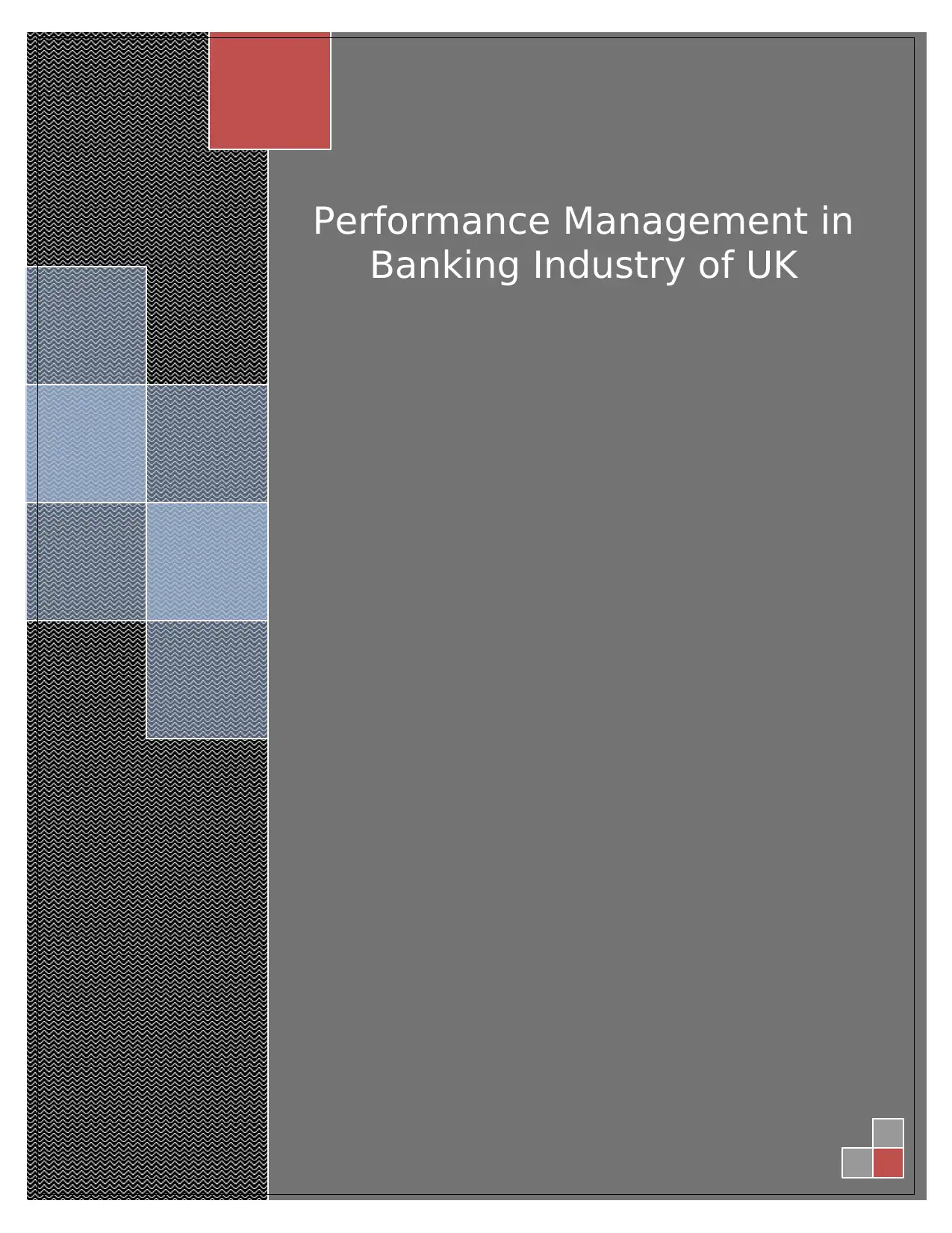
Performance Management in
Banking Industry of UK
Banking Industry of UK
Paraphrase This Document
Need a fresh take? Get an instant paraphrase of this document with our AI Paraphraser

ACKNOWLEDGEMENT

ABSTRACT
⊘ This is a preview!⊘
Do you want full access?
Subscribe today to unlock all pages.

Trusted by 1+ million students worldwide
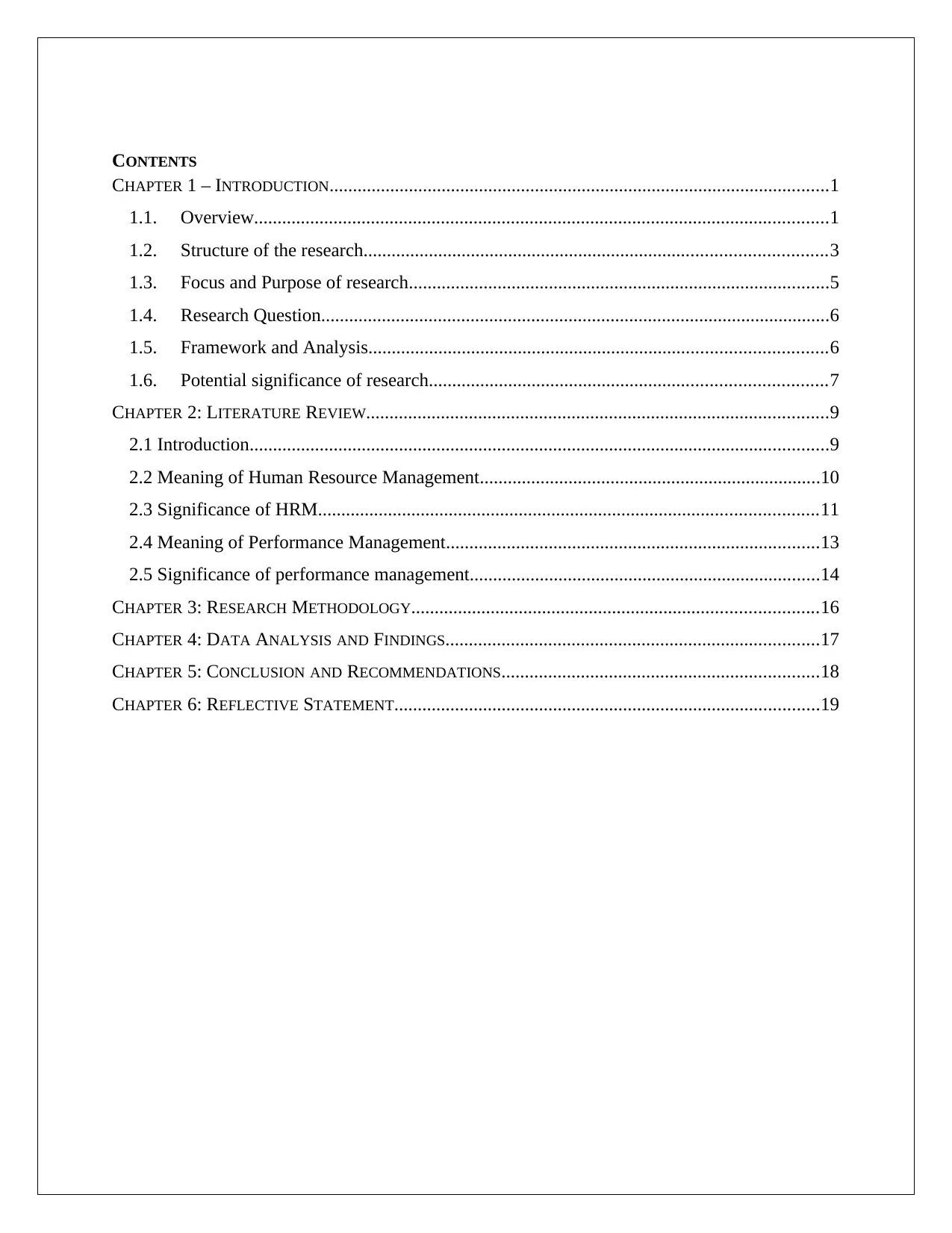
CONTENTS
CHAPTER 1 – INTRODUCTION...........................................................................................................1
1.1. Overview...........................................................................................................................1
1.2. Structure of the research...................................................................................................3
1.3. Focus and Purpose of research..........................................................................................5
1.4. Research Question.............................................................................................................6
1.5. Framework and Analysis..................................................................................................6
1.6. Potential significance of research.....................................................................................7
CHAPTER 2: LITERATURE REVIEW...................................................................................................9
2.1 Introduction............................................................................................................................9
2.2 Meaning of Human Resource Management.........................................................................10
2.3 Significance of HRM...........................................................................................................11
2.4 Meaning of Performance Management................................................................................13
2.5 Significance of performance management...........................................................................14
CHAPTER 3: RESEARCH METHODOLOGY.......................................................................................16
CHAPTER 4: DATA ANALYSIS AND FINDINGS................................................................................17
CHAPTER 5: CONCLUSION AND RECOMMENDATIONS....................................................................18
CHAPTER 6: REFLECTIVE STATEMENT...........................................................................................19
CHAPTER 1 – INTRODUCTION...........................................................................................................1
1.1. Overview...........................................................................................................................1
1.2. Structure of the research...................................................................................................3
1.3. Focus and Purpose of research..........................................................................................5
1.4. Research Question.............................................................................................................6
1.5. Framework and Analysis..................................................................................................6
1.6. Potential significance of research.....................................................................................7
CHAPTER 2: LITERATURE REVIEW...................................................................................................9
2.1 Introduction............................................................................................................................9
2.2 Meaning of Human Resource Management.........................................................................10
2.3 Significance of HRM...........................................................................................................11
2.4 Meaning of Performance Management................................................................................13
2.5 Significance of performance management...........................................................................14
CHAPTER 3: RESEARCH METHODOLOGY.......................................................................................16
CHAPTER 4: DATA ANALYSIS AND FINDINGS................................................................................17
CHAPTER 5: CONCLUSION AND RECOMMENDATIONS....................................................................18
CHAPTER 6: REFLECTIVE STATEMENT...........................................................................................19
Paraphrase This Document
Need a fresh take? Get an instant paraphrase of this document with our AI Paraphraser
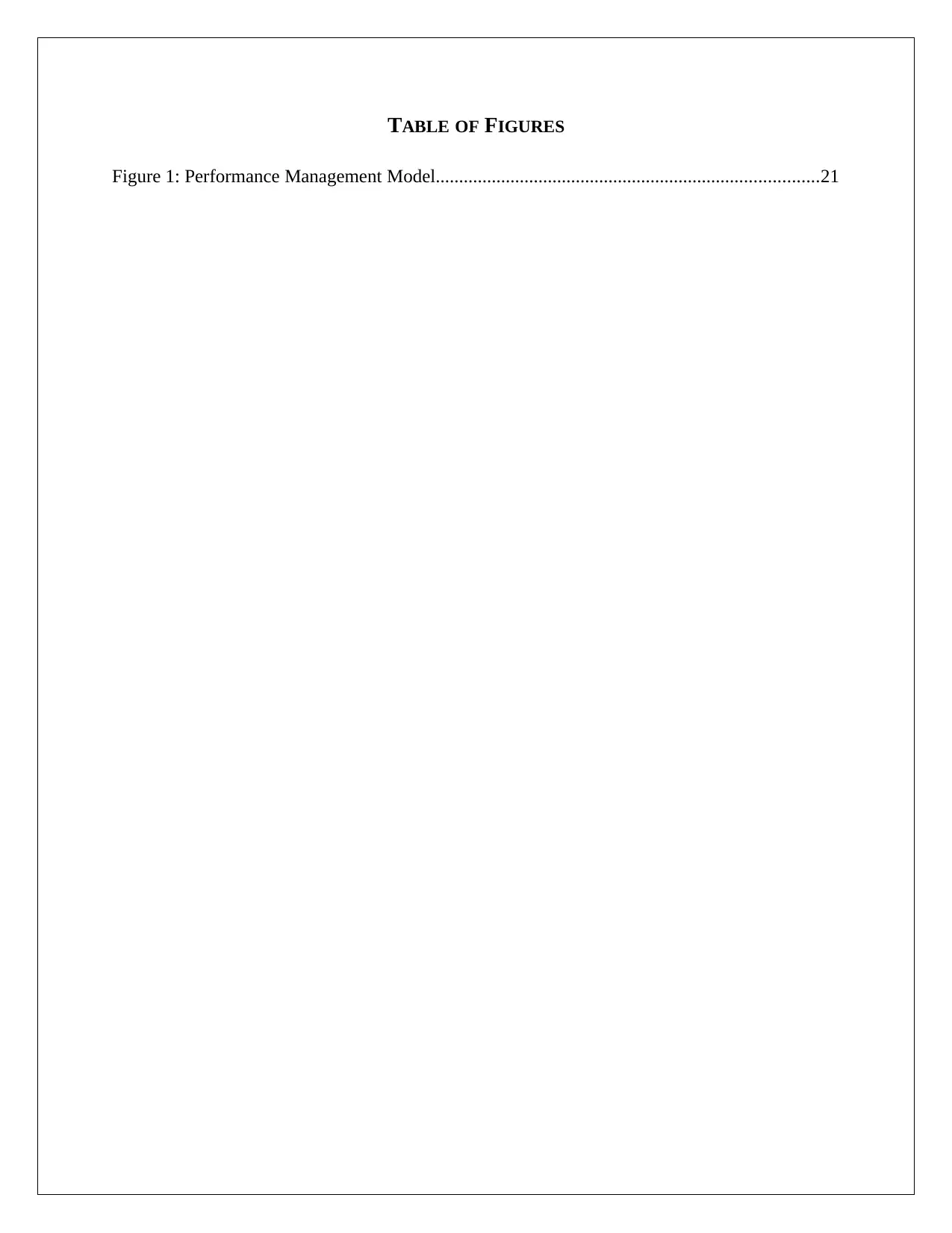
TABLE OF FIGURES
Figure 1: Performance Management Model..................................................................................21
Figure 1: Performance Management Model..................................................................................21
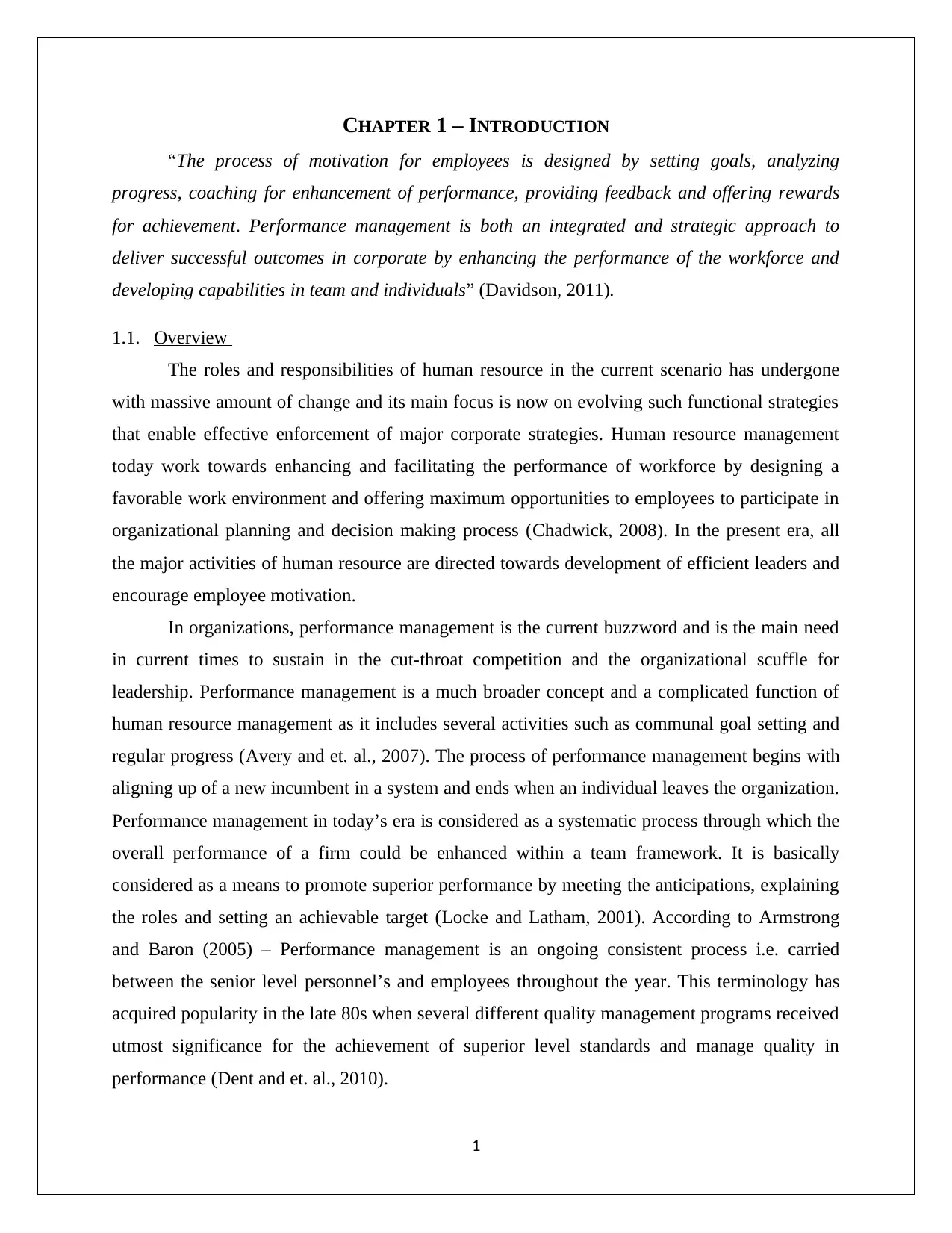
CHAPTER 1 – INTRODUCTION
“The process of motivation for employees is designed by setting goals, analyzing
progress, coaching for enhancement of performance, providing feedback and offering rewards
for achievement. Performance management is both an integrated and strategic approach to
deliver successful outcomes in corporate by enhancing the performance of the workforce and
developing capabilities in team and individuals” (Davidson, 2011).
1.1. Overview
The roles and responsibilities of human resource in the current scenario has undergone
with massive amount of change and its main focus is now on evolving such functional strategies
that enable effective enforcement of major corporate strategies. Human resource management
today work towards enhancing and facilitating the performance of workforce by designing a
favorable work environment and offering maximum opportunities to employees to participate in
organizational planning and decision making process (Chadwick, 2008). In the present era, all
the major activities of human resource are directed towards development of efficient leaders and
encourage employee motivation.
In organizations, performance management is the current buzzword and is the main need
in current times to sustain in the cut-throat competition and the organizational scuffle for
leadership. Performance management is a much broader concept and a complicated function of
human resource management as it includes several activities such as communal goal setting and
regular progress (Avery and et. al., 2007). The process of performance management begins with
aligning up of a new incumbent in a system and ends when an individual leaves the organization.
Performance management in today’s era is considered as a systematic process through which the
overall performance of a firm could be enhanced within a team framework. It is basically
considered as a means to promote superior performance by meeting the anticipations, explaining
the roles and setting an achievable target (Locke and Latham, 2001). According to Armstrong
and Baron (2005) – Performance management is an ongoing consistent process i.e. carried
between the senior level personnel’s and employees throughout the year. This terminology has
acquired popularity in the late 80s when several different quality management programs received
utmost significance for the achievement of superior level standards and manage quality in
performance (Dent and et. al., 2010).
1
“The process of motivation for employees is designed by setting goals, analyzing
progress, coaching for enhancement of performance, providing feedback and offering rewards
for achievement. Performance management is both an integrated and strategic approach to
deliver successful outcomes in corporate by enhancing the performance of the workforce and
developing capabilities in team and individuals” (Davidson, 2011).
1.1. Overview
The roles and responsibilities of human resource in the current scenario has undergone
with massive amount of change and its main focus is now on evolving such functional strategies
that enable effective enforcement of major corporate strategies. Human resource management
today work towards enhancing and facilitating the performance of workforce by designing a
favorable work environment and offering maximum opportunities to employees to participate in
organizational planning and decision making process (Chadwick, 2008). In the present era, all
the major activities of human resource are directed towards development of efficient leaders and
encourage employee motivation.
In organizations, performance management is the current buzzword and is the main need
in current times to sustain in the cut-throat competition and the organizational scuffle for
leadership. Performance management is a much broader concept and a complicated function of
human resource management as it includes several activities such as communal goal setting and
regular progress (Avery and et. al., 2007). The process of performance management begins with
aligning up of a new incumbent in a system and ends when an individual leaves the organization.
Performance management in today’s era is considered as a systematic process through which the
overall performance of a firm could be enhanced within a team framework. It is basically
considered as a means to promote superior performance by meeting the anticipations, explaining
the roles and setting an achievable target (Locke and Latham, 2001). According to Armstrong
and Baron (2005) – Performance management is an ongoing consistent process i.e. carried
between the senior level personnel’s and employees throughout the year. This terminology has
acquired popularity in the late 80s when several different quality management programs received
utmost significance for the achievement of superior level standards and manage quality in
performance (Dent and et. al., 2010).
1
⊘ This is a preview!⊘
Do you want full access?
Subscribe today to unlock all pages.

Trusted by 1+ million students worldwide
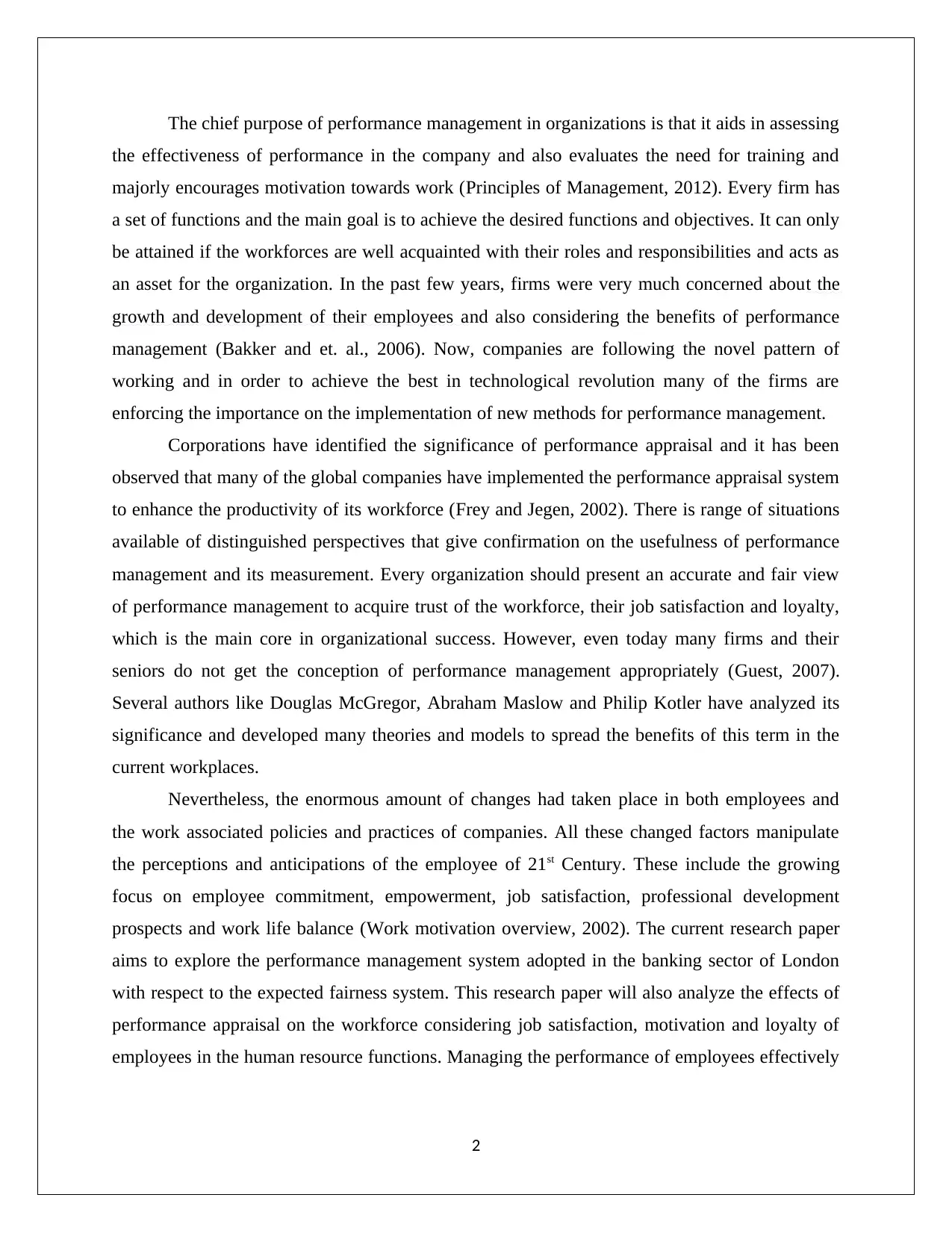
The chief purpose of performance management in organizations is that it aids in assessing
the effectiveness of performance in the company and also evaluates the need for training and
majorly encourages motivation towards work (Principles of Management, 2012). Every firm has
a set of functions and the main goal is to achieve the desired functions and objectives. It can only
be attained if the workforces are well acquainted with their roles and responsibilities and acts as
an asset for the organization. In the past few years, firms were very much concerned about the
growth and development of their employees and also considering the benefits of performance
management (Bakker and et. al., 2006). Now, companies are following the novel pattern of
working and in order to achieve the best in technological revolution many of the firms are
enforcing the importance on the implementation of new methods for performance management.
Corporations have identified the significance of performance appraisal and it has been
observed that many of the global companies have implemented the performance appraisal system
to enhance the productivity of its workforce (Frey and Jegen, 2002). There is range of situations
available of distinguished perspectives that give confirmation on the usefulness of performance
management and its measurement. Every organization should present an accurate and fair view
of performance management to acquire trust of the workforce, their job satisfaction and loyalty,
which is the main core in organizational success. However, even today many firms and their
seniors do not get the conception of performance management appropriately (Guest, 2007).
Several authors like Douglas McGregor, Abraham Maslow and Philip Kotler have analyzed its
significance and developed many theories and models to spread the benefits of this term in the
current workplaces.
Nevertheless, the enormous amount of changes had taken place in both employees and
the work associated policies and practices of companies. All these changed factors manipulate
the perceptions and anticipations of the employee of 21st Century. These include the growing
focus on employee commitment, empowerment, job satisfaction, professional development
prospects and work life balance (Work motivation overview, 2002). The current research paper
aims to explore the performance management system adopted in the banking sector of London
with respect to the expected fairness system. This research paper will also analyze the effects of
performance appraisal on the workforce considering job satisfaction, motivation and loyalty of
employees in the human resource functions. Managing the performance of employees effectively
2
the effectiveness of performance in the company and also evaluates the need for training and
majorly encourages motivation towards work (Principles of Management, 2012). Every firm has
a set of functions and the main goal is to achieve the desired functions and objectives. It can only
be attained if the workforces are well acquainted with their roles and responsibilities and acts as
an asset for the organization. In the past few years, firms were very much concerned about the
growth and development of their employees and also considering the benefits of performance
management (Bakker and et. al., 2006). Now, companies are following the novel pattern of
working and in order to achieve the best in technological revolution many of the firms are
enforcing the importance on the implementation of new methods for performance management.
Corporations have identified the significance of performance appraisal and it has been
observed that many of the global companies have implemented the performance appraisal system
to enhance the productivity of its workforce (Frey and Jegen, 2002). There is range of situations
available of distinguished perspectives that give confirmation on the usefulness of performance
management and its measurement. Every organization should present an accurate and fair view
of performance management to acquire trust of the workforce, their job satisfaction and loyalty,
which is the main core in organizational success. However, even today many firms and their
seniors do not get the conception of performance management appropriately (Guest, 2007).
Several authors like Douglas McGregor, Abraham Maslow and Philip Kotler have analyzed its
significance and developed many theories and models to spread the benefits of this term in the
current workplaces.
Nevertheless, the enormous amount of changes had taken place in both employees and
the work associated policies and practices of companies. All these changed factors manipulate
the perceptions and anticipations of the employee of 21st Century. These include the growing
focus on employee commitment, empowerment, job satisfaction, professional development
prospects and work life balance (Work motivation overview, 2002). The current research paper
aims to explore the performance management system adopted in the banking sector of London
with respect to the expected fairness system. This research paper will also analyze the effects of
performance appraisal on the workforce considering job satisfaction, motivation and loyalty of
employees in the human resource functions. Managing the performance of employees effectively
2
Paraphrase This Document
Need a fresh take? Get an instant paraphrase of this document with our AI Paraphraser
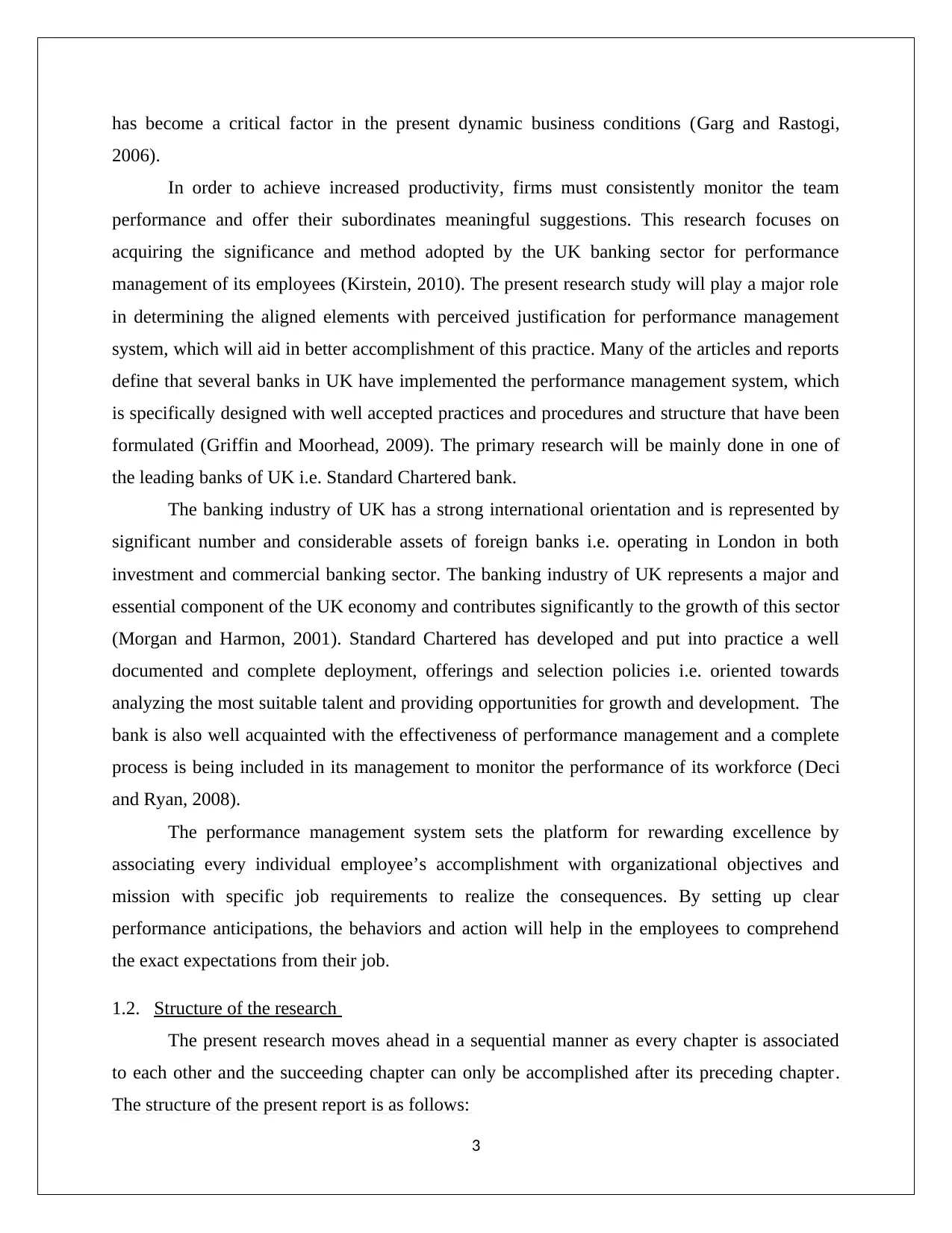
has become a critical factor in the present dynamic business conditions (Garg and Rastogi,
2006).
In order to achieve increased productivity, firms must consistently monitor the team
performance and offer their subordinates meaningful suggestions. This research focuses on
acquiring the significance and method adopted by the UK banking sector for performance
management of its employees (Kirstein, 2010). The present research study will play a major role
in determining the aligned elements with perceived justification for performance management
system, which will aid in better accomplishment of this practice. Many of the articles and reports
define that several banks in UK have implemented the performance management system, which
is specifically designed with well accepted practices and procedures and structure that have been
formulated (Griffin and Moorhead, 2009). The primary research will be mainly done in one of
the leading banks of UK i.e. Standard Chartered bank.
The banking industry of UK has a strong international orientation and is represented by
significant number and considerable assets of foreign banks i.e. operating in London in both
investment and commercial banking sector. The banking industry of UK represents a major and
essential component of the UK economy and contributes significantly to the growth of this sector
(Morgan and Harmon, 2001). Standard Chartered has developed and put into practice a well
documented and complete deployment, offerings and selection policies i.e. oriented towards
analyzing the most suitable talent and providing opportunities for growth and development. The
bank is also well acquainted with the effectiveness of performance management and a complete
process is being included in its management to monitor the performance of its workforce (Deci
and Ryan, 2008).
The performance management system sets the platform for rewarding excellence by
associating every individual employee’s accomplishment with organizational objectives and
mission with specific job requirements to realize the consequences. By setting up clear
performance anticipations, the behaviors and action will help in the employees to comprehend
the exact expectations from their job.
1.2. Structure of the research
The present research moves ahead in a sequential manner as every chapter is associated
to each other and the succeeding chapter can only be accomplished after its preceding chapter.
The structure of the present report is as follows:
3
2006).
In order to achieve increased productivity, firms must consistently monitor the team
performance and offer their subordinates meaningful suggestions. This research focuses on
acquiring the significance and method adopted by the UK banking sector for performance
management of its employees (Kirstein, 2010). The present research study will play a major role
in determining the aligned elements with perceived justification for performance management
system, which will aid in better accomplishment of this practice. Many of the articles and reports
define that several banks in UK have implemented the performance management system, which
is specifically designed with well accepted practices and procedures and structure that have been
formulated (Griffin and Moorhead, 2009). The primary research will be mainly done in one of
the leading banks of UK i.e. Standard Chartered bank.
The banking industry of UK has a strong international orientation and is represented by
significant number and considerable assets of foreign banks i.e. operating in London in both
investment and commercial banking sector. The banking industry of UK represents a major and
essential component of the UK economy and contributes significantly to the growth of this sector
(Morgan and Harmon, 2001). Standard Chartered has developed and put into practice a well
documented and complete deployment, offerings and selection policies i.e. oriented towards
analyzing the most suitable talent and providing opportunities for growth and development. The
bank is also well acquainted with the effectiveness of performance management and a complete
process is being included in its management to monitor the performance of its workforce (Deci
and Ryan, 2008).
The performance management system sets the platform for rewarding excellence by
associating every individual employee’s accomplishment with organizational objectives and
mission with specific job requirements to realize the consequences. By setting up clear
performance anticipations, the behaviors and action will help in the employees to comprehend
the exact expectations from their job.
1.2. Structure of the research
The present research moves ahead in a sequential manner as every chapter is associated
to each other and the succeeding chapter can only be accomplished after its preceding chapter.
The structure of the present report is as follows:
3
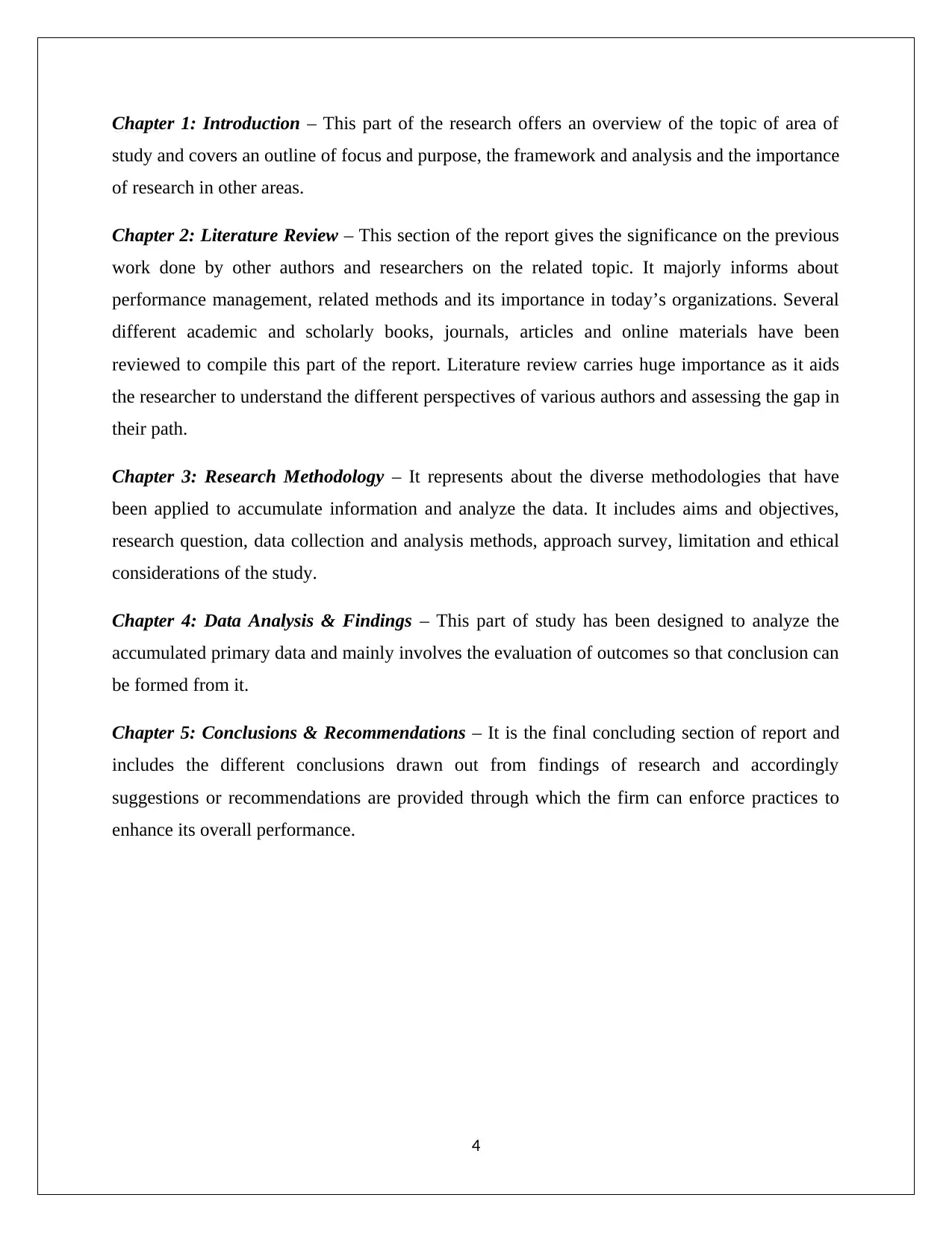
Chapter 1: Introduction – This part of the research offers an overview of the topic of area of
study and covers an outline of focus and purpose, the framework and analysis and the importance
of research in other areas.
Chapter 2: Literature Review – This section of the report gives the significance on the previous
work done by other authors and researchers on the related topic. It majorly informs about
performance management, related methods and its importance in today’s organizations. Several
different academic and scholarly books, journals, articles and online materials have been
reviewed to compile this part of the report. Literature review carries huge importance as it aids
the researcher to understand the different perspectives of various authors and assessing the gap in
their path.
Chapter 3: Research Methodology – It represents about the diverse methodologies that have
been applied to accumulate information and analyze the data. It includes aims and objectives,
research question, data collection and analysis methods, approach survey, limitation and ethical
considerations of the study.
Chapter 4: Data Analysis & Findings – This part of study has been designed to analyze the
accumulated primary data and mainly involves the evaluation of outcomes so that conclusion can
be formed from it.
Chapter 5: Conclusions & Recommendations – It is the final concluding section of report and
includes the different conclusions drawn out from findings of research and accordingly
suggestions or recommendations are provided through which the firm can enforce practices to
enhance its overall performance.
4
study and covers an outline of focus and purpose, the framework and analysis and the importance
of research in other areas.
Chapter 2: Literature Review – This section of the report gives the significance on the previous
work done by other authors and researchers on the related topic. It majorly informs about
performance management, related methods and its importance in today’s organizations. Several
different academic and scholarly books, journals, articles and online materials have been
reviewed to compile this part of the report. Literature review carries huge importance as it aids
the researcher to understand the different perspectives of various authors and assessing the gap in
their path.
Chapter 3: Research Methodology – It represents about the diverse methodologies that have
been applied to accumulate information and analyze the data. It includes aims and objectives,
research question, data collection and analysis methods, approach survey, limitation and ethical
considerations of the study.
Chapter 4: Data Analysis & Findings – This part of study has been designed to analyze the
accumulated primary data and mainly involves the evaluation of outcomes so that conclusion can
be formed from it.
Chapter 5: Conclusions & Recommendations – It is the final concluding section of report and
includes the different conclusions drawn out from findings of research and accordingly
suggestions or recommendations are provided through which the firm can enforce practices to
enhance its overall performance.
4
⊘ This is a preview!⊘
Do you want full access?
Subscribe today to unlock all pages.

Trusted by 1+ million students worldwide
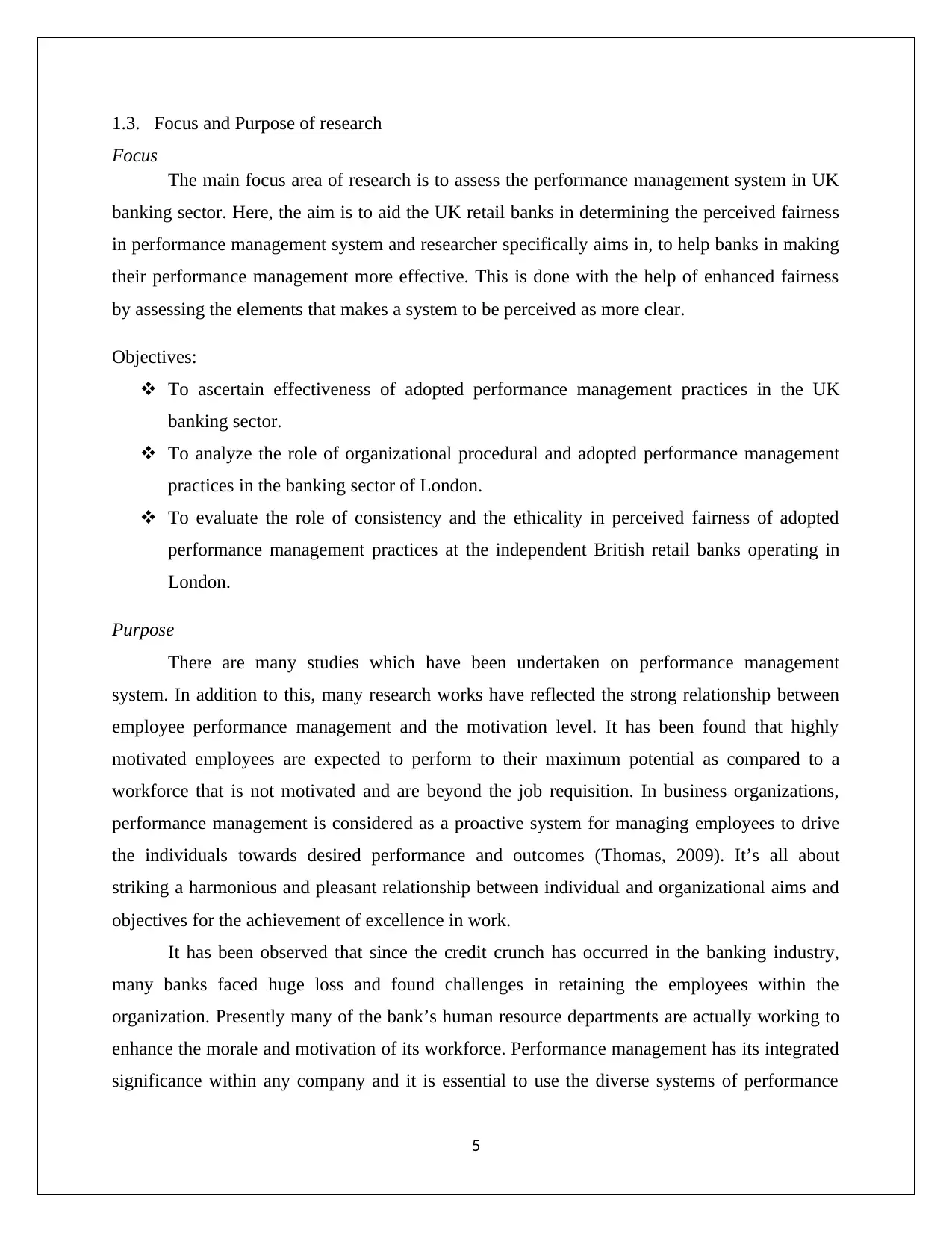
1.3. Focus and Purpose of research
Focus
The main focus area of research is to assess the performance management system in UK
banking sector. Here, the aim is to aid the UK retail banks in determining the perceived fairness
in performance management system and researcher specifically aims in, to help banks in making
their performance management more effective. This is done with the help of enhanced fairness
by assessing the elements that makes a system to be perceived as more clear.
Objectives:
To ascertain effectiveness of adopted performance management practices in the UK
banking sector.
To analyze the role of organizational procedural and adopted performance management
practices in the banking sector of London.
To evaluate the role of consistency and the ethicality in perceived fairness of adopted
performance management practices at the independent British retail banks operating in
London.
Purpose
There are many studies which have been undertaken on performance management
system. In addition to this, many research works have reflected the strong relationship between
employee performance management and the motivation level. It has been found that highly
motivated employees are expected to perform to their maximum potential as compared to a
workforce that is not motivated and are beyond the job requisition. In business organizations,
performance management is considered as a proactive system for managing employees to drive
the individuals towards desired performance and outcomes (Thomas, 2009). It’s all about
striking a harmonious and pleasant relationship between individual and organizational aims and
objectives for the achievement of excellence in work.
It has been observed that since the credit crunch has occurred in the banking industry,
many banks faced huge loss and found challenges in retaining the employees within the
organization. Presently many of the bank’s human resource departments are actually working to
enhance the morale and motivation of its workforce. Performance management has its integrated
significance within any company and it is essential to use the diverse systems of performance
5
Focus
The main focus area of research is to assess the performance management system in UK
banking sector. Here, the aim is to aid the UK retail banks in determining the perceived fairness
in performance management system and researcher specifically aims in, to help banks in making
their performance management more effective. This is done with the help of enhanced fairness
by assessing the elements that makes a system to be perceived as more clear.
Objectives:
To ascertain effectiveness of adopted performance management practices in the UK
banking sector.
To analyze the role of organizational procedural and adopted performance management
practices in the banking sector of London.
To evaluate the role of consistency and the ethicality in perceived fairness of adopted
performance management practices at the independent British retail banks operating in
London.
Purpose
There are many studies which have been undertaken on performance management
system. In addition to this, many research works have reflected the strong relationship between
employee performance management and the motivation level. It has been found that highly
motivated employees are expected to perform to their maximum potential as compared to a
workforce that is not motivated and are beyond the job requisition. In business organizations,
performance management is considered as a proactive system for managing employees to drive
the individuals towards desired performance and outcomes (Thomas, 2009). It’s all about
striking a harmonious and pleasant relationship between individual and organizational aims and
objectives for the achievement of excellence in work.
It has been observed that since the credit crunch has occurred in the banking industry,
many banks faced huge loss and found challenges in retaining the employees within the
organization. Presently many of the bank’s human resource departments are actually working to
enhance the morale and motivation of its workforce. Performance management has its integrated
significance within any company and it is essential to use the diverse systems of performance
5
Paraphrase This Document
Need a fresh take? Get an instant paraphrase of this document with our AI Paraphraser
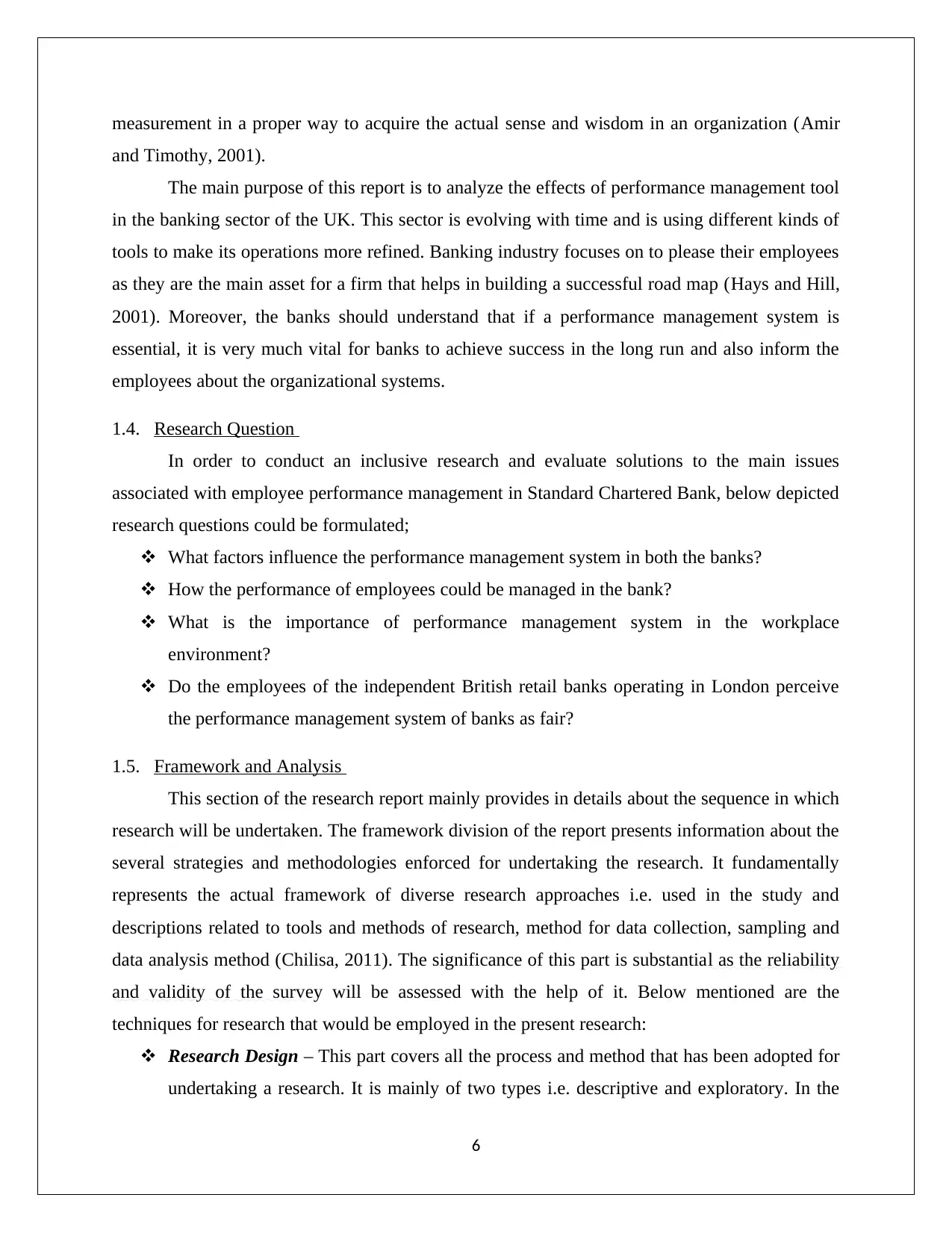
measurement in a proper way to acquire the actual sense and wisdom in an organization (Amir
and Timothy, 2001).
The main purpose of this report is to analyze the effects of performance management tool
in the banking sector of the UK. This sector is evolving with time and is using different kinds of
tools to make its operations more refined. Banking industry focuses on to please their employees
as they are the main asset for a firm that helps in building a successful road map (Hays and Hill,
2001). Moreover, the banks should understand that if a performance management system is
essential, it is very much vital for banks to achieve success in the long run and also inform the
employees about the organizational systems.
1.4. Research Question
In order to conduct an inclusive research and evaluate solutions to the main issues
associated with employee performance management in Standard Chartered Bank, below depicted
research questions could be formulated;
What factors influence the performance management system in both the banks?
How the performance of employees could be managed in the bank?
What is the importance of performance management system in the workplace
environment?
Do the employees of the independent British retail banks operating in London perceive
the performance management system of banks as fair?
1.5. Framework and Analysis
This section of the research report mainly provides in details about the sequence in which
research will be undertaken. The framework division of the report presents information about the
several strategies and methodologies enforced for undertaking the research. It fundamentally
represents the actual framework of diverse research approaches i.e. used in the study and
descriptions related to tools and methods of research, method for data collection, sampling and
data analysis method (Chilisa, 2011). The significance of this part is substantial as the reliability
and validity of the survey will be assessed with the help of it. Below mentioned are the
techniques for research that would be employed in the present research:
Research Design – This part covers all the process and method that has been adopted for
undertaking a research. It is mainly of two types i.e. descriptive and exploratory. In the
6
and Timothy, 2001).
The main purpose of this report is to analyze the effects of performance management tool
in the banking sector of the UK. This sector is evolving with time and is using different kinds of
tools to make its operations more refined. Banking industry focuses on to please their employees
as they are the main asset for a firm that helps in building a successful road map (Hays and Hill,
2001). Moreover, the banks should understand that if a performance management system is
essential, it is very much vital for banks to achieve success in the long run and also inform the
employees about the organizational systems.
1.4. Research Question
In order to conduct an inclusive research and evaluate solutions to the main issues
associated with employee performance management in Standard Chartered Bank, below depicted
research questions could be formulated;
What factors influence the performance management system in both the banks?
How the performance of employees could be managed in the bank?
What is the importance of performance management system in the workplace
environment?
Do the employees of the independent British retail banks operating in London perceive
the performance management system of banks as fair?
1.5. Framework and Analysis
This section of the research report mainly provides in details about the sequence in which
research will be undertaken. The framework division of the report presents information about the
several strategies and methodologies enforced for undertaking the research. It fundamentally
represents the actual framework of diverse research approaches i.e. used in the study and
descriptions related to tools and methods of research, method for data collection, sampling and
data analysis method (Chilisa, 2011). The significance of this part is substantial as the reliability
and validity of the survey will be assessed with the help of it. Below mentioned are the
techniques for research that would be employed in the present research:
Research Design – This part covers all the process and method that has been adopted for
undertaking a research. It is mainly of two types i.e. descriptive and exploratory. In the
6
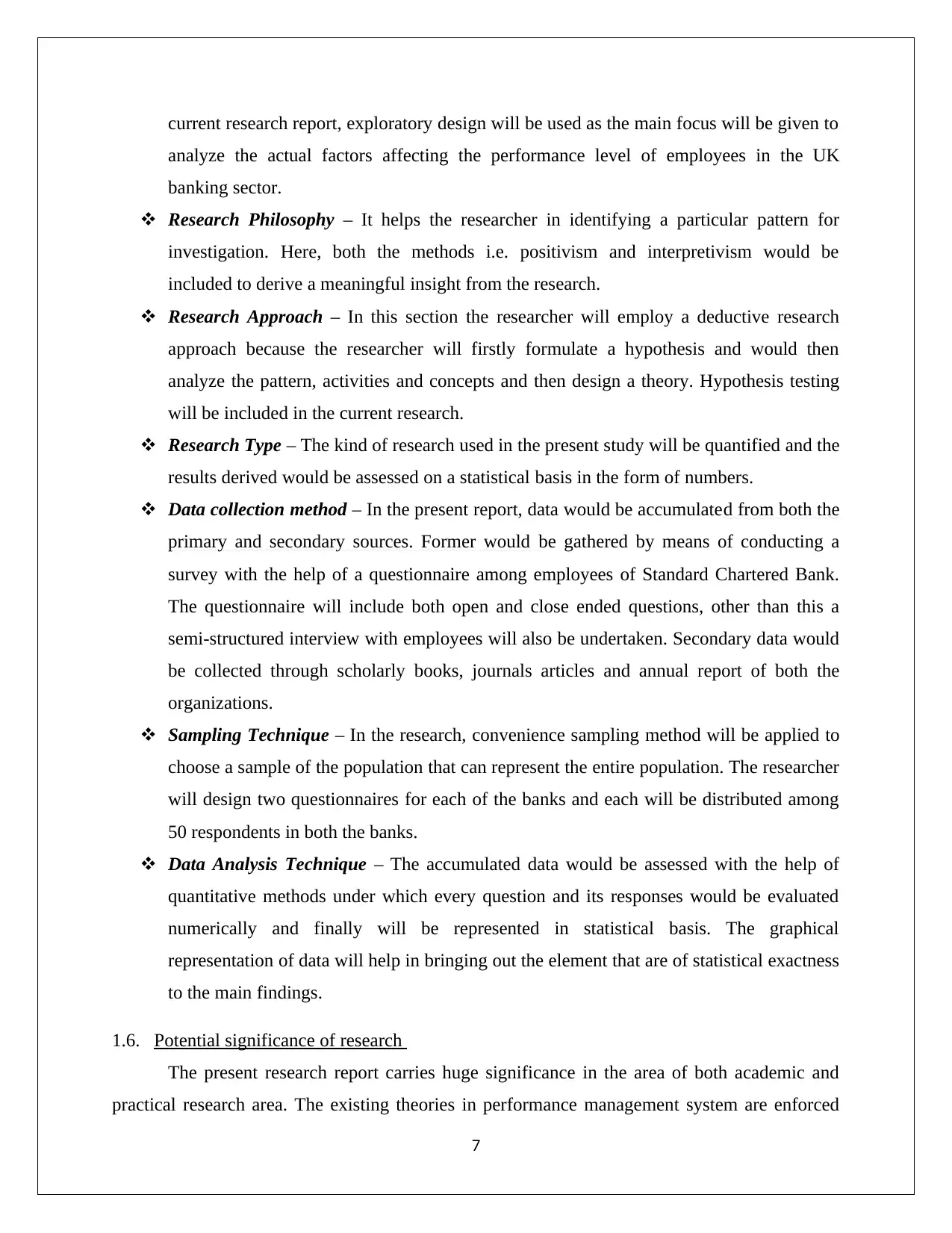
current research report, exploratory design will be used as the main focus will be given to
analyze the actual factors affecting the performance level of employees in the UK
banking sector.
Research Philosophy – It helps the researcher in identifying a particular pattern for
investigation. Here, both the methods i.e. positivism and interpretivism would be
included to derive a meaningful insight from the research.
Research Approach – In this section the researcher will employ a deductive research
approach because the researcher will firstly formulate a hypothesis and would then
analyze the pattern, activities and concepts and then design a theory. Hypothesis testing
will be included in the current research.
Research Type – The kind of research used in the present study will be quantified and the
results derived would be assessed on a statistical basis in the form of numbers.
Data collection method – In the present report, data would be accumulated from both the
primary and secondary sources. Former would be gathered by means of conducting a
survey with the help of a questionnaire among employees of Standard Chartered Bank.
The questionnaire will include both open and close ended questions, other than this a
semi-structured interview with employees will also be undertaken. Secondary data would
be collected through scholarly books, journals articles and annual report of both the
organizations.
Sampling Technique – In the research, convenience sampling method will be applied to
choose a sample of the population that can represent the entire population. The researcher
will design two questionnaires for each of the banks and each will be distributed among
50 respondents in both the banks.
Data Analysis Technique – The accumulated data would be assessed with the help of
quantitative methods under which every question and its responses would be evaluated
numerically and finally will be represented in statistical basis. The graphical
representation of data will help in bringing out the element that are of statistical exactness
to the main findings.
1.6. Potential significance of research
The present research report carries huge significance in the area of both academic and
practical research area. The existing theories in performance management system are enforced
7
analyze the actual factors affecting the performance level of employees in the UK
banking sector.
Research Philosophy – It helps the researcher in identifying a particular pattern for
investigation. Here, both the methods i.e. positivism and interpretivism would be
included to derive a meaningful insight from the research.
Research Approach – In this section the researcher will employ a deductive research
approach because the researcher will firstly formulate a hypothesis and would then
analyze the pattern, activities and concepts and then design a theory. Hypothesis testing
will be included in the current research.
Research Type – The kind of research used in the present study will be quantified and the
results derived would be assessed on a statistical basis in the form of numbers.
Data collection method – In the present report, data would be accumulated from both the
primary and secondary sources. Former would be gathered by means of conducting a
survey with the help of a questionnaire among employees of Standard Chartered Bank.
The questionnaire will include both open and close ended questions, other than this a
semi-structured interview with employees will also be undertaken. Secondary data would
be collected through scholarly books, journals articles and annual report of both the
organizations.
Sampling Technique – In the research, convenience sampling method will be applied to
choose a sample of the population that can represent the entire population. The researcher
will design two questionnaires for each of the banks and each will be distributed among
50 respondents in both the banks.
Data Analysis Technique – The accumulated data would be assessed with the help of
quantitative methods under which every question and its responses would be evaluated
numerically and finally will be represented in statistical basis. The graphical
representation of data will help in bringing out the element that are of statistical exactness
to the main findings.
1.6. Potential significance of research
The present research report carries huge significance in the area of both academic and
practical research area. The existing theories in performance management system are enforced
7
⊘ This is a preview!⊘
Do you want full access?
Subscribe today to unlock all pages.

Trusted by 1+ million students worldwide
1 out of 42
Related Documents
Your All-in-One AI-Powered Toolkit for Academic Success.
+13062052269
info@desklib.com
Available 24*7 on WhatsApp / Email
![[object Object]](/_next/static/media/star-bottom.7253800d.svg)
Unlock your academic potential
Copyright © 2020–2025 A2Z Services. All Rights Reserved. Developed and managed by ZUCOL.





